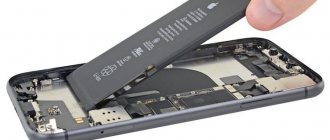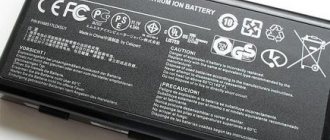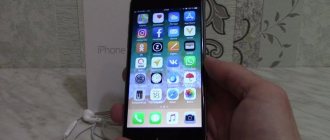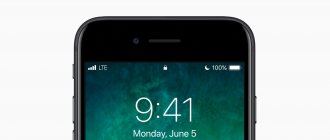The debate about which type of battery in smartphones is better has not faded away for a long time, but manufacturers still continue to produce smartphones with non-removable batteries, which is inconvenient in the opinion of many. What are their differences, the pros and cons of each solution? Let's try to figure it out.
Once upon a time, all smartphones came with a battery that you could remove at any time. Thanks to this, you could quickly reboot your smartphone if something went wrong or quickly replace the battery with a second, fully charged one. Or, in the end, you can easily replace the old, exhausted battery with a new one. Everything changed in 2007 when Apple introduced its first iPhone.
Soon, in all new devices on Windows Phone and Symbian, the battery turned out to be non-removable. Nokia E7, X7, Lumia 800, HTC Radar - access to the battery is prohibited in all of these devices. However, it’s not just a matter of copying the iPhone idea and distrusting users: such batteries are in many ways better than their removable counterparts.
If you look at smartphones on each platform, the percentage of use of removable and non-removable batteries is approximately the same, which reflects the balance of the pros and cons of each type.
Non-removable batteries (Apple iPhone, Nokia E7, X7, Lumia 800, HTC Radar)
Advantages:
- batteries can have any shape, passing between other components, which allows you to make the device more compact, and the batteries themselves - more capacious
- The design of a phone with a non-removable battery is often simpler and more reliable
- the user will not be able to insert batteries from third-party manufacturers into the phone, which can lead to breakdown or even fire of the phone
Flaws:
- These batteries have no alternative charging options other than via USB or the charger itself
- when the battery capacity decreases over time, you have to take the phone to an authorized service center and pay not only for the battery itself, but also for work to replace it
- there is no way to take a second, spare battery in case of a long trip
Traditional, removable batteries (Nokia N95, N97, E6, 808 PureView, Lumia 710, HTC HD7)
Advantages:
- Such batteries can be purchased relatively inexpensively, stored in pockets and quickly replaced if necessary.
- when the battery capacity depletes over time, you can simply throw away the old one and buy/insert a new one
- in case of problems with the smartphone (freezes), you can remove the battery, thereby turning off the phone, and then turn it on again
- third-party batteries can provide greater capacity in virtually the same size and are easy to replace
Flaws:
- Since such batteries are smaller than their non-removable counterparts, their capacity is noticeably lower due to the form factor
- batteries should be of a standard shape for ease of installation and storage
- batteries from third-party manufacturers must be selected extremely carefully, as they may not provide the promised capacity and may even be dangerous to use
The Department of Chemical Engineering from the University of South Carolina provided a graph whose data is quite scary. As the number of charge/discharge cycles of a battery increases, its voltage, capacity and performance rapidly decrease. Over the course of a year of use, the battery with a capacity of 1800mAh dropped to 1350mAh.
Of course, it also matters that the country in which the testing was carried out is known for its hot climate, and Li-Ion batteries are extremely sensitive to temperature. If the temperature stays above 30°C, any battery will lose some of its capacity, regardless of time. Also, a lot depends on when users charge their phones. If you charge your phone whenever possible, without waiting for a large discharge, this is good. If your phone is discharged to such an extent that it literally asks to be charged, the harm to the battery increases significantly.
If you add these two factors together: high temperature and deep discharge of the battery by the user, you get a reduction in battery capacity by 50% per year, in less than 500 cycles. In this case, you may be lucky and you will be able to replace the battery of your smartphone while still under warranty, saving money.
Let me give you my example of catastrophic degradation of a non-removable battery: we took our Macbook to a service center last week because the battery life did not exceed 10 minutes! Diagnostics showed that the number of cycles in 14 months from the date of purchase was about 600, the battery capacity dropped by 50%, and the voltage was slightly higher than the minimum required by the computer. The result was opening the 'sealed' Macbook and replacing the battery. Price - 100 euros. Not cheap.
Of course, it should have lived much longer, but my daughter almost always took it to charge only when the battery was already completely empty. Deep discharges almost every time...
Li-Ion batteries cannot 'just work' because they are complex chemical compounds in which Lithium ions float between the cathode and anode through an electrolyte. After a while, the electrodes become 'passive' and the chemical reaction can no longer function well, losing capacitance and voltage. Compare this to the rest of your phone, which remains the same month after month. The case may get a few scratches, the AMOLED display may darken slightly, but the battery, which is the main consumable, will quickly become unusable. That is why you should not refuse to use removable batteries.
However, despite all this negativity, using non-removable batteries will not be a particular problem, because an experienced user will charge the phone regularly (without waiting for the discharge to drop below 50%). At this consumption, the number of cycles before battery degradation will increase from several hundred to several thousand.
In the hands of an enthusiast, the chances of the battery lasting more than 18 months are extremely low. However, usually by this time the battery becomes another person's problem or the phone itself goes into the drawer.
I have smartphones that are more than five years old, and therefore, before giving them to someone, I replace the battery with a new one or buy a spare one, because any device must be used as it was originally intended, and not at 1/2 the battery capacity.
It also upsets me that my iPhone, Nokia E7 or Lumia 800, despite their perfect appearance, already use only 80% of the battery capacity, or even less, and I can’t do anything about it.
What type of batteries do you prefer? What is your experience with batteries lasting more than a few years?
As it turns out, the “non-removable” battery is very easy to change. All it takes is a little courage and watching a couple of videos on YouTube. I have already ordered a bunch of spare parts for electronics from Ali before. We changed glass and speakers in phones, and even laptop screens, without paying a single ruble to the services.
The battery was packed in a standard bubble wrap. My link to the battery has burned out. There are minor differences in the font and placement of the inscriptions, but, in general, everything is the same as the old battery.
To remove the back cover of the phone, you need to carefully and sequentially release all the latches with a thin tool without damaging them. A plastic card, a scalpel or even a fingernail will do. If you have a tool for repairing phones, that’s great. The only special equipment we will need is a very small square screwdriver.
If you don’t have such a screwdriver, order it in advance - on Ali, repair kits cost pennies. This is what the old battery looks like. Soft, like plasticine and pretty battered by life.
I, like a good girl, did not throw it in the trash, but will take it to a collection point for used batteries, and I do not advise you to pollute the environment. We can't change the world, but we can make it at least a little better. The battery arrived charged by as much as 54%, which really surprised me. Thanks to the Chinese, I also saved on charging my phone.
The mount that holds the battery has noticeably stretched, because the old one was very swollen. But this does not affect the fixation of the new one.
During assembly, I lost the SIM card plug, and then spent a long time looking for it. Don’t do what I did - don’t carry your disassembled phone from place to place, even for photos, and disassemble it over light paper or a large towel.
A little life hack: I really don’t like protective glass and bumpers - that’s not why I bought a phone with a white back panel. Over two years of use, the back panel has become very worn and scratched (I often put the phone with keys or small change), and the camera began to shoot like a cloudy three-megapixel camera. I was upset and prepared to order a new original socket with glass for the camera in China for as much as 9! dollars. But my boyfriend suggested polishing the phone with car polish (no car needed) and my camera is taking decent photos again and the scratches on the plastic are almost gone! A little later we’ll try to polish the phone with a machine, maybe it will be even better.
The battery began to discharge more slowly, but 2450 milliamps is still very little. But, unfortunately, I can’t install a more powerful one into my phone. When I actively use the Internet, I put the phone down for a few hours, it gets terribly hot and glitches, and when charging, if you touch the camera with your finger, you can feel it receiving a slight electric shock. Eh, who would send a new phone with a cool camera for review...
PS The photos in the review were taken on a Huawei ascend mate 7 phone, I apologize for their low quality.
PPS Today is my birthday, and I still haven’t chosen a gift for myself. Dear readers, please advise a phone number within 20-30 tr. with a good camera (for blogging). The quality of the photos saddens me so much that I even start looking towards iPhones, although I have never had an iPhone. Are iPhone cameras as good as they say? I also thought about taking a closer look at Sony, I heard good reviews about them. Or is it easier to buy a DSLR? A photographer I know offered a Canon 60D “carcass” for 19,000 rubles, but it seemed to me that this was a little expensive for this photo quality, especially since you still need to buy a lens. To be honest, I have very little understanding of all this, I just want sharp photos.
The battery and its characteristics are one of the key parameters by which you should choose a smartphone. After all, the ease of using the phone will depend on them. If the battery does not have enough power, you will have to constantly charge it. That is, mobility decreases, and you are constantly tied to an outlet. At the same time, if the battery has a large capacity, this increases the size of the phone. It is unlikely that anyone would want to carry a brick in their pocket. It is also important to choose between the design of the battery: removable or non-removable. Recently, more and more phones with non-removable batteries have appeared. In this article we will talk about their pros and cons.
Previously, even before the advent of the smartphone class, almost all phones had removable batteries. However, everything changed after the appearance of the Apple iPhone on the market. After this, the number of models with a non-removable battery began to increase sharply. Moreover, they began to be produced by a variety of manufacturers. Phones with a non-removable battery are available in different price categories and run various operating systems (Android, Windows Phone, Symbian). If you need it, then read the review at the link.
Why did phones with non-removable batteries begin to gain popularity? The main impetus for development in this case was the attractive design.
The non-removable battery allows manufacturers to make the device much thinner and more attractive than in the case of phones with a removable battery. Manufacturers could not ignore this opportunity, and Apple was the first to set the trend in this direction.
Let's take a closer look at all the pros and cons of smartphones with removable and non-removable batteries.
Phone with non-removable battery
pros
- Manufacturers have freedom in designing the design of the battery and the phone itself. Non-removable batteries can bend around and pass through other components of the device. As a result, they are releasing more compact smartphones with powerful batteries;
- if the battery is non-removable, then the design of the phone can often be made simpler and more reliable than in the case of a removable battery;
- The non-removable battery acts as “fool proof”. That is, the user will not be able to install a low-quality battery into the phone by mistake or inexperience. It is worth recalling that installing low-quality lithium batteries may cause the phone to catch fire
; - The assembly of the case is performed to a higher quality. In those phones that do not have a removable battery, there are practically no backlashes, nothing creaks, and the body has better protection from moisture and dust.
Minuses
- devices with a non-removable battery can only be charged using a standard charger or via a USB interface;
- There is no option to use a second battery to extend battery life. In principle, nothing prevents you from using a power bank;
- If you lose a significant part of the capacity, you will have to contact a service center to replace it.
Which one is better to choose?
Now the buyer does not have much choice. Inexpensive phones may still come with a removable cover, but more premium products have largely abandoned this. Therefore, in most cases there is no choice.
However, if there is still a choice, a solid body is a priority. It has more significant advantages than removable options. Such cases are more stylish, thin and light. They do not make strong squeaks, do not crumble when dropped, and have better moisture protection.
Phone with removable battery
pros
- If the battery loses its capacity during operation, you can remove it and replace it with a new one yourself;
- Removable batteries are inexpensive, you can buy a spare one
; - you can purchase a battery from another manufacturer, which will have a larger capacity than the standard battery;
- If the phone freezes, you can remove the battery and reset the settings to factory settings.
Minuses
- You need to carefully select batteries from third-party manufacturers. It is not enough to simply choose a model with similar characteristics. You also need to carefully choose the manufacturer. We recommend purchasing batteries from certified companies;
- Since removable batteries are limited to a certain form factor, their capacity is less than non-removable ones.
Non-removable battery replacement process
Nowadays, even kids have modern gadgets that they can use with skill. By the way, even for them, replacing the battery or recharging it is not a difficult task. From the outside, in general, it seems as if they were born with such devices. However, the situation is different if you need to replace the built-in battery in a smartphone.
Most gadget owners are simply at a loss as to whether it is possible to replace the non-removable battery in a smartphone at all or whether they will have to say goodbye to it affectionately and instead buy a new one, exposing their wallet to another “barbaric” devastation. And even when the question of whether it is possible to change the non-removable battery in a smartphone is answered in the affirmative, the problems do not end there.
A new problem appears, the owners are trying to figure out how feasible it is to carry out such a procedure on their own or whether they must contact a service center.
It is, of course, easier to go to a service center, but at the same time you will have to come to terms with the thought of financial losses. And for some owners, such a trip is not realistic, since they live in the outback, where there is no talk of service centers. In fact, there are no particular difficulties in carrying out such manipulations; it is important to act confidently, but very carefully, having first studied the instructions on how to remove the non-removable battery from the phone.
Some phone models with non-removable batteries
We can say that the fashion for non-removable batteries started with the iPhone. The iPhone 6 Plus model has a 5.5-inch IPS display with a resolution of 1920 by 1080 pixels. The display contrast is 1300:1 and the brightness is 500 cd/m2. The heart of the device is the 64-bit A8 processor.
Dual-core processor with a clock frequency of 1400 MHz. The PowerVR GX6650 chip is responsible for graphics processing. The amount of RAM is 1 GB. The internal memory capacity is 16 GB.
This smartphone with a non-removable battery has a 5-inch diagonal IPS display with a resolution of 1024 by 768 pixels.
The basis of the hardware platform is the NVIDIA Tegra 3 chip with a clock frequency of 1500 MHz. It consists of 4 ARM Cortex-A9 cores + 1. The amount of RAM is 1 GB, and the internal memory is 32 GB. The front and rear cameras have a resolution of 1.3 and 8 megapixels, respectively.
The operating system of LG Optimus Vu is Android 4.0. The non-removable battery has a capacity of 2080 mAh.
Below you can watch a video about replacing the battery on the LG Optimus Vu.
The phone is designed as a candy bar with a non-removable battery. The smartphone display has a diagonal of 4.3 inches and supports Mobile Bravia Engine technology. The resolution is 1280 by 720 pixels. The main Xperia S has a 12 megapixel Sony Exmor R sensor and sixteen times digital zoom. There is also autofocus with object selection on the display, LED flash, facial recognition, auto scene selection, stabilizer, Sweep Panorama, etc. are supported.
Xperia S has a 3.5 mm headphone jack, through which you can listen to FM radio and music tracks. For communication with the outside world there are Wi-Fi, Bluetooth, USB, HDMI, NFC, DLNA modules. GLONASS support is implemented, and the capacity of the non-removable battery is 1750 mAh.
Below, watch a video on replacing the battery on a Sony Xperia S. At the same time, you can read the material about.
The smartphone display has a diagonal of 5.1 inches with a resolution of 2560 by 1440 pixels. The hardware platform is based on a 64-bit Exynos 7420 chip. It includes four A53 and A57 cores. They operate at clock speeds of up to 2100 MHz. The Mali-T760 core is responsible for graphics processing. The phone has 3 GB of LPDDR4 RAM. Internal memory can be 32, 64 or 128 gigabytes.
The smartphone runs Android 5.0.2. The front and rear cameras have a resolution of 5 and 16 megapixels, respectively. The main camera has support for OIS, True HDR, autofocus, F 1.9, Pro mode and other functionality.
There is a Wi-Fi module, Bluetooth, an infrared port for controlling equipment in the house, USB 2.0 and NFC. The non-removable lithium-ion battery has a capacity of 2550 mAh. It supports extreme power saving mode and fast charging in an hour.
The emergence of telephone models with non-removable batteries marked a new milestone in the development of mobile technology. This solution makes it possible to reduce the dimensions and increase the overall tightness of the device, however, at the same time, difficulties arise when it becomes necessary to replace a worn-out battery. In this current article, we will look at how to replace a non-removable battery in a smartphone from Samsung, LG, Xiaomi and other popular brands.
Reasons for introducing non-removable batteries
A significant part of modern smartphones are protected from dust and moisture, and some are even able to survive immersion to shallow depths. The introduction of such indicators required achieving a certain degree of tightness of the case, and the back cover, which provides access to the battery, was always the weak link in the chain.
The transition to non-removable batteries made it possible to make the design one-piece. In addition, the change significantly affected the dimensions of mobile devices - they became thinner. The presence of a battery built into the design allows you to vary its location and form factor. Thus, the iPhone 9 was equipped with L-shaped batteries with increased capacity, without increasing the overall size of the device.
Is it possible to remove the built-in battery?
Yes. But this is done through the display. It needs to be heated, then using special suction cups and a card, tear it off from the body. Then unscrew the screws, remove the cable, remove the inside of the device and only then start working with the battery.
The battery itself has remained virtually unchanged. In all mobile devices it is rectangular or square in shape and is inserted into a special compartment for the contacts. Only in the case of the non-removable option, the batteries have thinner walls and there is no serious protection around them.
Often they are installed directly on the structural materials of the device, without having their own department. This is done to save space and improve ergonomics. It does not affect reliability in any way, since everything is perfectly protected by the main body.
Smartphone models with non-removable batteries
Currently, it is easier to name models that come with removable batteries than vice versa. Initially, a smartphone with a non-removable battery was released by Apple - again, through the efforts of its designers, it set a trend for the rest of the world and other mobile device manufacturers in particular. The iPhone 6 Plus with a 5.5-inch diagonal IPS display and all subsequent models of this smartphone have this characteristic.
The South Korean giant is not far behind, releasing the Samsung Galaxy S6 with a battery built into the body. This model has a 5.1-inch screen and a powerful processor.
LG presented customers with the Optimus Vu (P895) phone, which has the same modern feature, allowing it to significantly reduce its dimensions. Sony's first model with a non-removable battery was the Xperia S, HTC's was the One X. A video with the disassembly of all of these devices can be found freely available via the Internet, and then we will present generalized instructions and recommendations for performing the procedure.
To take or not to take - that is the question
You can find many arguments for and against a non-removable battery in a smartphone. It is impossible to unambiguously decide which position is correct on this issue. In any case, it is quite difficult to find a device that is ideal in all technical characteristics. Each buyer has his own set of parameters by which he chooses a phone. If durability is one of them, you should pay attention to models with a removable battery. And if modern design, performance, large battery capacity and other bonuses of modern devices are important, you need to choose from all the devices currently available. And if the smartphone you love has only one drawback - the quality of its non-removable battery, you should not refuse the purchase.
How to change a non-removable battery in a smartphone
First of all, you need to figure out how to disconnect the back cover from the rest of the case. In some models, this will require unscrewing the bolts located on the edges; on others, it is enough to pry off the joint with thin plastic.
For further operation you need:
- Remove all foreign elements from the phone: SIM cards, memory card, connector covers.
- Detach the back cover.
- Inspect the inside of the smartphone, which is accessible after removing the cover. Depending on the model, a protective panel may be present here. If this is the case, it is removed by unscrewing the fastening screws. You may need a specific shaped screwdriver that is different from a Phillips or flathead screwdriver.
- The next step in the instructions on how to remove a non-removable battery in a phone is to determine where the cable will be attached. This is necessary so that during removal the wiring contacts are not damaged.
- The battery is now disconnected from the case. Often it is placed on an adhesive base, which requires careful implementation of the procedure. You should use a plastic scraper and disconnect all sides of the battery step by step.
- The cable is disconnected and a new battery is connected.
- Many modern devices are valued not only for their functionality, but also for their elegant design. Sometimes, in order to create a gadget with a more interesting appearance, you have to change some design features. This is how the first non-removable battery appeared. In fact, it is the same lithium battery as it is removable. The main difference is that it is not intended to be replaced by the owner of the phone. The pioneer in the use of such power supplies was Apple, whose marketing policy is completely consistent with installing a non-removable device on a smartphone.
Nickel-metal hybrid batteries
They did not contain toxic cadmium, the mere mention of which causes hysterics among particularly impressionable environmentalists. In addition, the memory effect was much weaker.
The capacity has also increased, and the cost, on the contrary, has decreased slightly. But there were serious disadvantages compared to NiCd batteries:
- the need to use a complex charger;
- reducing the number of charge/discharge cycles.
Both types of batteries were subject to a fairly high degree of self-discharge, which seriously limited the autonomy of mobile devices based on them. And when the next generation appeared on the horizon, the designers threw them into the dustbin of history with a joyful squeal.
Comparison of removable and non-removable batteries
It would be wrong to say that now every mobile phone is equipped with a similar battery; it all depends on the manufacturer. From the point of view of functionality, that is, capacity, operating time in different modes and reliability, non-removable batteries do not differ from their “readily available” counterparts. For comparison, you can take two models produced by Samsung and having approximately the same market value.
The J5 Prime is the only smartphone in the Galaxy series to come with a replaceable battery. Specifications declared by the manufacturer: 54 hours in audio playback mode, ~12 in video playback mode, 16 hours of talk time on the GSM network.
Other phones in this series are equipped with non-removable batteries. Stated characteristics: 71 hours of music, 17 hours of video, 21 hours of talk time when using a GSM connection.
There is a difference, but it is not critical, especially since the Samsung J5 is equipped with a slightly more powerful power supply - 3100 mAh versus 2400 mAh for the J5 Prime.
To correctly choose the most suitable option, you need to understand exactly what the pros and cons of non-removable batteries in your phone are.
Let's start with the pros:
Despite the fact that this is more a design decision than a technical one, installing a battery that the user cannot replace on his own is a kind of
“foolproofing”
. The fact is that not all power supplies on the market belong to equally conscientious manufacturers, and not every smartphone owner bothers to find a new battery that is ideal for it. From this point of view, non-removable batteries protect the gadget from the consequences of working with an unsuitable device.
from dust, dirt and accidental moisture.
with a back wall made of any materials.
, and the problem with the breakage of the rear cover holding device has safely disappeared.
Phones equipped with non-removable batteries also have several disadvantages.
The first and most important is the main design feature, that is, the inability to replace the power source, since this is:
- does not allow the use of spare batteries;
- makes it difficult to dry a phone that has been submerged in water;
- It makes it possible to independently replace a battery that has become old and has lost its capacity.
In the modern world, all these problems (except for the drowning of the device) already have one solution or another. Instead of a spare battery, you can purchase one, which is an excellent portable charger. Modern gadgets become obsolete in 1.5 - 2 years, and during this time a non-removable power supply is unlikely to wear out that much.
There are only two unsolved disadvantages:
- The first of them
is the impossibility of forcibly rebooting the smartphone if there is some kind of “glitch” and the power button does not respond. - The second
is situations when a large amount of water has gotten inside the gadget and you need to figure out how to dry it effectively.
Usually the first advice in this case is to immediately turn off the power source. How to dry a phone that has non-removable batteries?
First, let's talk about what you definitely shouldn't do. Drying your phone with a hairdryer or similar device that generates hot air is a great method to ensure that your lithium battery is destroyed. Using a vacuum cleaner to blow out moisture will also not work.
There is only one option left. You can dry the non-removable battery using rice or silica gel. To do this, you need to pour the adsorbent into a bag, put the phone in it and tie it tightly. It is advisable to monitor the phone, if necessary, wiping off any moisture that has appeared every hour.
The problem of the modern electronic world
Young people who are accustomed to updating their smartphones as new and exciting new products are released will most likely not remember that the very first cell phones could last for many years, and some still work properly.
In modern society, everyone is so accustomed to the fact that technology is short-lived, quickly becomes obsolete and requires constant replacement, that it is unlikely to be possible to move away from this. Manufacturers keep coming up with new technologies, inventing the most modern devices, but in the end it all comes down to reducing the service life of the equipment. We can talk endlessly about the pros and cons of a non-removable battery in a smartphone, but the trend is moving towards a complete abandonment of removable batteries. The world of technology and electronics is constantly evolving, every year more and more diverse new products and ideas for improving production appear, and no matter how much you would like to go back to the past, it is impossible to do so. All that remains is not to be hostile to everything new and unusual and, if possible, try to find positive aspects in everything.
How to turn off your phone if it's frozen
How to turn off a phone with a non-removable battery if it suddenly freezes and refuses to follow user commands? If the smartphone has a removable battery, then there are no problems: you just need to take it out and put it back in. When the battery is not removable, and you have to deal with this for the first time, a feeling of confusion sets in: the person simply does not know what to do. It's good that there are several simple ways to help solve this problem.
- If your Apple phone is frozen
, you need to hold down two buttons at the same time for several seconds: Home and the start (power) button. This activates the quick reboot process while saving all the necessary data. There is no resetting of the current settings: perhaps this is the best method of all that can be used. - What to do if your Sony smartphone freezes?
The presence of a removable cover on many phone models of this company allows you to solve the problem using the Power off button. It needs to be clamped with something thin and held for several seconds. If the Sony cover cannot be removed, this is also not the worst option: in order for the phone to start rebooting, pull up the volume button while simultaneously pressing the power button. The device should turn off immediately. - What to do if your HTC smartphone freezes?
Here, too, everything is extremely simple and accessible: there are two ways to solve the problem. The first is to hold down the power button until the device starts to reboot. The second - the same as in the case of Sony, the cover of which is not removable - press the volume up, simultaneously with the power button of the device. - How to turn off a phone with a non-removable battery if it is Samsung?
It will be enough to simply hold the power button for 10-20 seconds until vibration appears inside the device. This means that the reboot has begun and there is nothing more to worry about.
What to do if you have a different phone model? The same as with the others: also hold down the power button until the device reboots, and if this does not help, we work with the volume and power buttons, simultaneously holding them down until the smartphone starts to reboot.
Both types of batteries have objective advantages. Removable allows the owner to customize the gadget for himself, but also requires responsibility and ability to handle equipment. Fixed is an excellent choice for a person who wants to buy and use without delving into technical difficulties.
conclusions
Everyone decides for themselves whether to buy a smartphone with a traditional removable battery or sacrifice this option for the sake of design and build quality. Simply, if a non-removable battery is the only drawback of the model you have chosen, feel free to buy yourself a device, not paying attention to prejudices.
As it turns out, the “non-removable” battery is very easy to change. All it takes is a little courage and watching a couple of videos on YouTube. I have already ordered a bunch of spare parts for electronics from Ali before. We changed glass and speakers in phones, and even laptop screens, without paying a single ruble to the services.
The battery was packed in a standard bubble wrap. My link to the battery has burned out. There are minor differences in the font and placement of the inscriptions, but, in general, everything is the same as the old battery.
To remove the back cover of the phone, you need to carefully and sequentially release all the latches with a thin tool without damaging them. A plastic card, a scalpel or even a fingernail will do. If you have a tool for repairing phones, that’s great. The only special equipment we will need is a very small square screwdriver.
If you don’t have such a screwdriver, order it in advance - on Ali, repair kits cost pennies. This is what the old battery looks like. Soft, like plasticine and pretty battered by life.
I, like a good girl, did not throw it in the trash, but will take it to a collection point for used batteries, and I do not advise you to pollute the environment. We can't change the world, but we can make it at least a little better. The battery arrived charged by as much as 54%, which really surprised me. Thanks to the Chinese, I also saved on charging my phone.
The mount that holds the battery has noticeably stretched, because the old one was very swollen. But this does not affect the fixation of the new one.
During assembly, I lost the SIM card plug, and then spent a long time looking for it. Don’t do what I did - don’t carry your disassembled phone from place to place, even for photos, and disassemble it over light paper or a large towel.
A little life hack: I really don’t like protective glass and bumpers - that’s not why I bought a phone with a white back panel. Over two years of use, the back panel has become very worn and scratched (I often put the phone with keys or small change), and the camera began to shoot like a cloudy three-megapixel camera. I was upset and prepared to order a new original socket with glass for the camera in China for as much as 9! dollars. But my boyfriend suggested polishing the phone with car polish (no car needed) and my camera is taking decent photos again and the scratches on the plastic are almost gone! A little later we’ll try to polish the phone with a machine, maybe it will be even better.
The battery began to discharge more slowly, but 2450 milliamps is still very little. But, unfortunately, I can’t install a more powerful one into my phone. When I actively use the Internet, I put the phone down for a few hours, it gets terribly hot and glitches, and when charging, if you touch the camera with your finger, you can feel it receiving a slight electric shock. Eh, who would send a new phone with a cool camera for review...
PS The photos in the review were taken on a Huawei ascend mate 7 phone, I apologize for their low quality.
PPS Today is my birthday, and I still haven’t chosen a gift for myself. Dear readers, please advise a phone number within 20-30 tr. with a good camera (for blogging). The quality of the photos saddens me so much that I even start looking towards iPhones, although I have never had an iPhone. Are iPhone cameras as good as they say? I also thought about taking a closer look at Sony, I heard good reviews about them. Or is it easier to buy a DSLR? A photographer I know offered a Canon 60D “carcass” for 19,000 rubles, but it seemed to me that this was a little expensive for this photo quality, especially since you still need to buy a lens. To be honest, I have very little understanding of all this, I just want sharp photos.
Smartphone manufacturers continue to wage an unspoken race to minimize the size of the gadget. Note that the electronic filling itself takes up very little space in the device body. Large space is needed for the battery.
Today, the optimal solution, which allows you to save not only space, but also weight, is to install non-removable batteries. They are made in a flexible case and are soldered with contacts directly to the device’s motherboard. If they fail, an analogue can be purchased online. Spare parts for mobile phones can be delivered to almost anywhere in the world.
At the first stage, it is very important to parse the gadget correctly. The fact is that today, in the vast majority of cases, device cases are secured using latches.
Without some nuances, unfastening them is unlikely to be possible in the correct way. This is achieved either using a specialized plastic spatula (sold in a set with other tools for repairing modern electronics), or using an ordinary plastic card.
Accuracy should also include understanding the structure of the device. After all, not everyone knows that some cables go to the back covers. A sudden movement can lead to a break.
A cable is not a wire that can be cut and soldered again. Repairing a cable of such miniature dimensions is almost impossible. The only way to restore it is to completely replace it with a new analogue.
Of course, before unsoldering the battery, it is recommended to make sure that the gadget is completely turned off and not in sleep mode. Some repairmen recommend completely discharging the battery and only then dismantling it.
The procedure looks like this:
- a corresponding tip is put on the soldering iron;
- heating should be carried out locally;
- It is recommended to remove battery contacts using tweezers.
If you overheat the battery contact, the track on the back of the via hole may fall off. After all, the boards used in such devices are exclusively multilayer.
Often, independent repairs result in the complete destruction of the gadget.
The video shows the process of replacing the battery on Lenovo A5000:
Tweet











